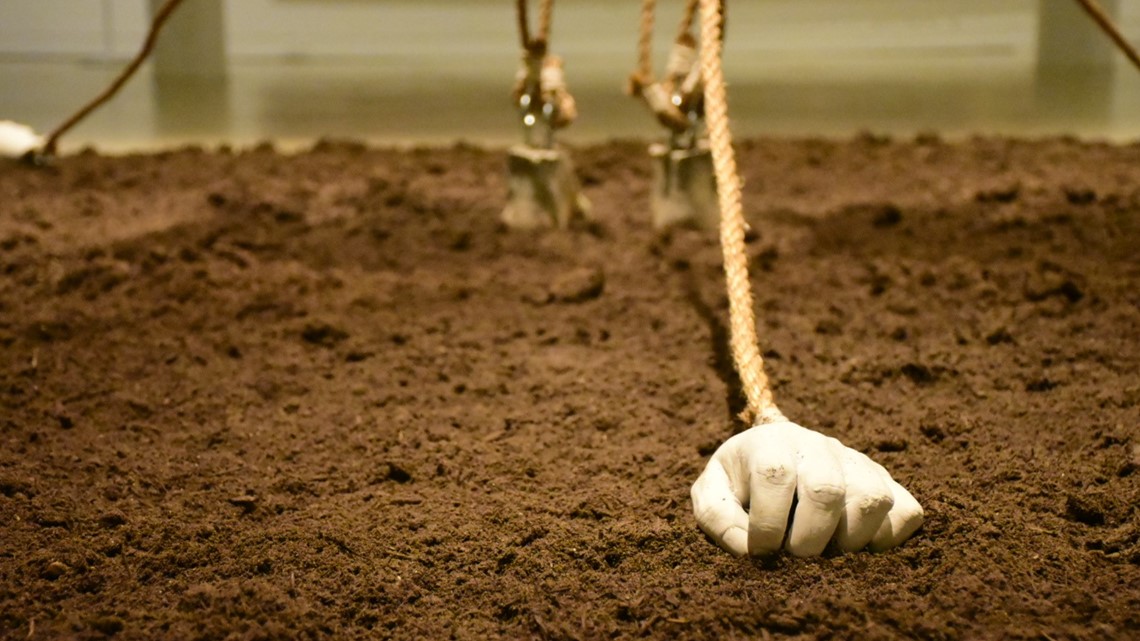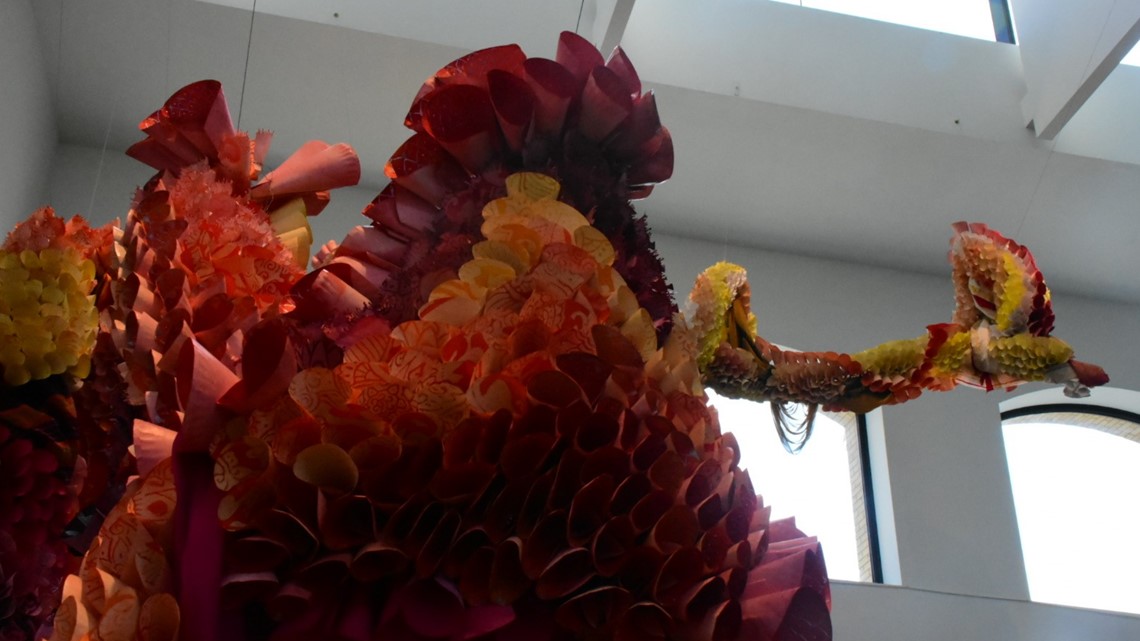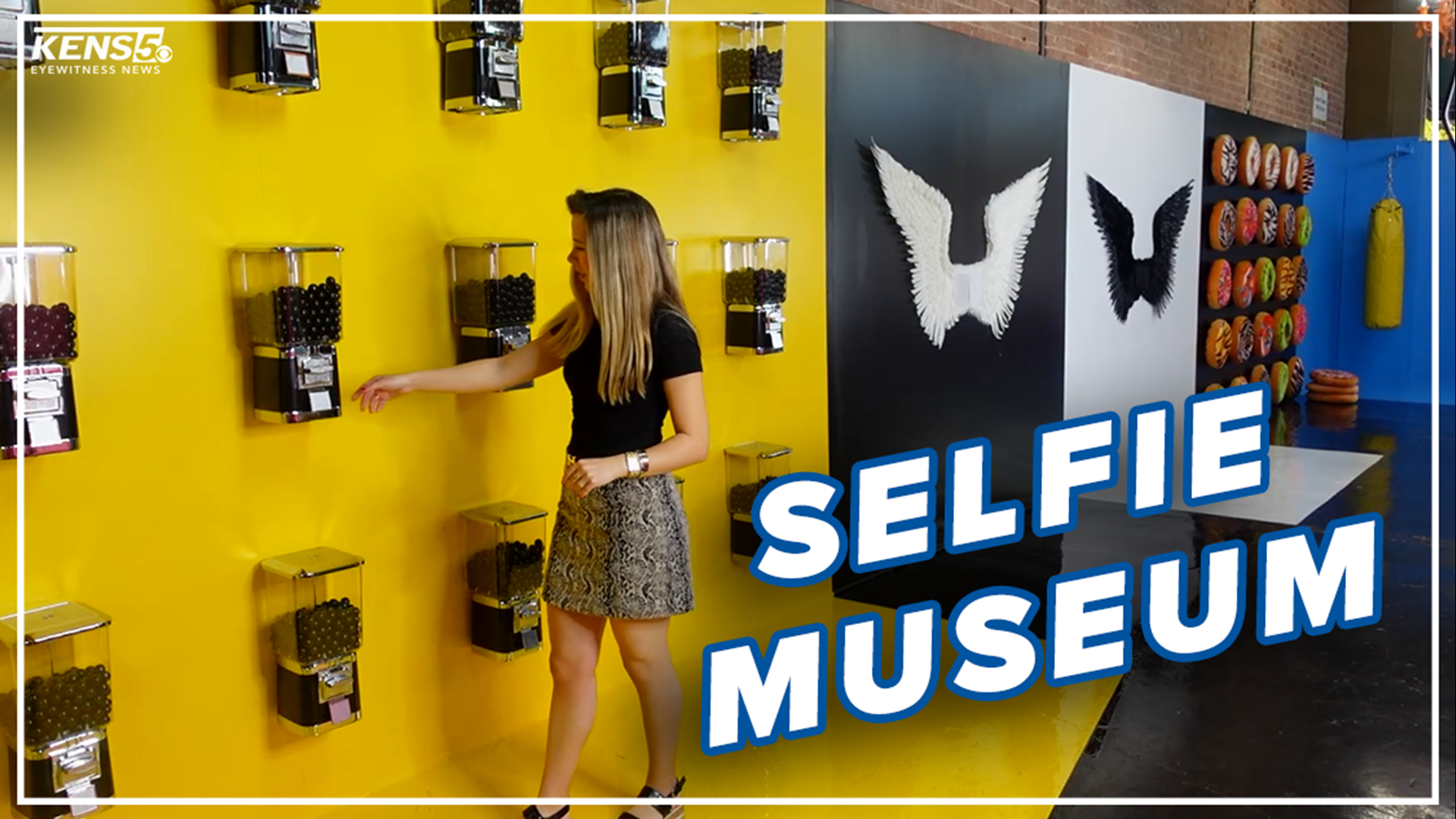SAN ANTONIO — While artistic industries across the country have been constrained and confined for the better part of the last two years, the co-curators of the 2021 Texas Biennial opted for a pandemic-defying mindset while planning their version of the massive exhibit: One of expansion.
Organized by the Austin nonprofit Big Medium since 2005, the returning showcase for contemporary Texas art has collaborated with various galleries across the state over the years while enlisting new curators for each iteration. 2021, however, marks the first time the biennial opened itself up to works from both those who have emigrated to the state and native Texans who have left (the show refers to them as “Texpats”) but remain inspired by its cities and landscapes, its variety of flavors and traditions.
“Given the history of the previous iterations of the biennial, we were primarily interested in how we could – even before COVID – how we could differentiate this project from different iterations,” said Evan Garza, who curated the 2021 exhibit alongside fellow Houston native Ryan Dennis. “How we could expand the conversation beyond the terms of previous iterations.”
That conversation turned into a biennial officially titled “A New Landscape, A Possible Horizon.” It features 51 artists contributing 175 artworks running the gamut of mediums and messages, a spectrum of sizes and even sounds. There are works of paint and metal, others of audio and video. Some creations you walk under and others you walk around, like Alamo City resident Jose Villalobos’s “Los Pies Que Te Cargaron,” which blends wood, stone and earth into a magnetic display of “deconstructing and altering” the toxicity of machismo through the objects associated with them, per his artist statement.


“The hope is that people get to know artists from Texas and really have some understanding of the influence Texas has had on artists, and how they work in contemporary practice if they stay in the state or leave the state,” Dennis said.
The Alamo City’s role in the 2021 edition of the biennial marks an expansion as well. While in the past the exhibit brought installations to Blue Star Arts Complex, no fewer than four San Antonio museums are hosting works this year—Artpace, Ruby City, the McNay and San Antonio Museum of Art.
“This is great to be a focus,” said Kathy Armstrong, director of residencies and exhibitions at downtown San Antonio’s Artpace. “I remember maybe a dozen years ago it was fully in Austin. With this year’s Texas Biennial being in San Antonio, it really does encourage someone to visit our pillar institutions—the institutions that are presenting the best of contemporary art to the City of San Antonio.”
But while Dennis and Garza always knew they wanted to expand the idea of what the biennial could be, featuring it in so many venues – San Antonio’s four as well as FotoFest in Houston – wasn’t always in the blueprints. If it wasn’t for the pandemic, it may not have even happened.
‘Responding to the present moment’
Having first hit it off at a 2017 event in Houston, Garza and Dennis knew they wanted to curate an exhibit like the Texas Biennial together.
It turns out getting the gig was the easy part.
After some initial in-person meetings and visits at the end of 2019, the pandemic arrive stateside. And planning for the exhibit meant utilizing everything from texts and emails to Zooms and voice memos.
“99.5% of the biennial was all done by virtual means,” Garza said. “Not to toot our own horn, but I think we really pulled it off.”
In early 2020, though, uncertainty was the new normal. Museums went quiet and the future was hazy. Though Garza and Dennis were still in the early phases of the curation process, an in-person event was still the goal.
But while the 2017 Texas Biennial was entirely housed in one Austin space, repeating that strategy no longer made sense from a public-health standpoint. That’s when discussions of broadening the exhibit over multiple cities in Texas began. It complicated some logistics, but it also meant widening the spotlight for the featured artists.
“The more that we began to go down that path, the more we realized that it would be fabulous both in terms of support and visibility, but also in terms of validation, if we could partner with Texas institutions,” Garza said.
In the spring of 2020, with vaccines still months away and in-person gatherings of any kind still on hold, the phones at San Antonio’s museums began to ring.
“Big Medium, which is based in Austin, reached out to us about being a host, and we gladly accepted,” said Eddie Hayes, exhibitions senior manager at the McNay, which this fall is hosting the biggest 2021 Texas Biennial showcase with 41 total pieces. “It’s a show of solidarity that we’re doing this together, that we’re all supporting Texas art, or art about Texas at the very least.”
The first artwork McNay visitors may notice is one they actually hear—a 3-D configuration of brass horns which look as though they’ve been mashed together, playing recordings of “songs of distress as a call to action,” contrasting the idea of sirens as we know them from Greek mythology. Hanging nearby is a sky-blue-colored slab of painted wood peppered with holes to indicate respiratory droplets, a testament to the two health crises of AIDS and COVID-19 that the artist, Daniel Moffett, has lived through.
The biennial at the McNay also extends to outside, where a cast-iron installation by Jarrod Beck harkens to images of various lines we may have seen during the pandemic, whether at food banks or testing sites. Hayes makes a point to mention how the work on display here and at the other four partner institutions was created by artists during, and drawing from, a period of isolation.
“All of the art here is responding to the present moment, and what artists have been experiencing,” he said.
That makes the works on display at the 2021 Texas Biennial not just contemporary, but artifacts from a period of time that isn’t likely to escape anyone’s memory soon; a moment defined by more than just masks and PPE.
“There are a number of artists in the project that are interested in immigrant rights and immigrant activism, racial and social justice and environmental issues and activism,” Garza said. “And those are issues that are incredibly relevant right now.”
‘You’re never quite sure...what you might find’
It wouldn’t be until the summer of 2021 that the museums’ participation was in full swing as curators, artists and gallery staff began collaborating on how exhibits would be organized. It also wouldn’t be until the summer of 2021 that Garza and Dennis, the closest of collaborators during the pandemic, saw each other in the flesh for the first time in 18 months.
More than a personal milestone, it was a sign that things were headed in the right direction for the Texas Biennial to be an in-person experience.
“We were just longing to reconnect in person,” Dennis said. “I guess these are the moments when you thank God for technology, just to have the means to organize during this time, but the last 20-something months have been...it’s kind of wild to even think about, conceptually organizing an exhibition (when) you’re not in real space and time with people.”
San Antonio’s museums and galleries were starting to welcome back patrons for the first time in over a year as well. Though the venues were hands-off when it came to which pieces they would display, they did work with Big Medium when it came to installation. Some of the bigger pieces, like a massive sculpture made of hundreds of ornately decorated paper plates reaching from floor to ceiling at the San Antonio Museum of Art’s lobby, seemed destined for certain spaces.
“Probably for this piece we were one of the only ones that had enough space (to display it),” SAMA Spokesperson Emilie Dujour said of the colorful installation. “And we’re very excited because this piece is very, very pretty, but also people are interacting with it.”


Dujour said SAMA has tightened its focus on showcasing Texas artists as of late, making the museum an appropriate host for the biennial. A few miles south, in the South Flores neighborhood, Ruby City Director Elyse Gonzales noted San Antonians can make an eventful day out of diving into the majority of the 2021 Texas Biennial’s exhibits while visiting a quartet of local arts institutions in the process.
“I think what’s nice is that, given San Antonio’s relatively compact area where these cultural arts institutions are located, it allows the exhibition to really take shape and form because you can go see everything all in one day if you want,” Gonzales said. “It just allows the venues to speak to each other in a really direct and meaningful way.”
Depending on where you are, the pieces in any given venue can be in conversation with each other as well. That much is true at Ruby City, where eight works on display “reference history through objects,” as Gonzales puts it, and ignite reflections on racial justice and oppression. The gallery’s low lighting is meant to channel a “subdued and contemplative state.”
One of the more captivating works at Ruby City is Mich Stevenson’s “Yellowjacket,” which combines canvas, steel and acrylic to create what appears as three imposing figures wearing gold-colored cloaks. The title refers to the insects, which makes its nest underground—and, much like the theme Dennis and Garza adopted in their curation effort, expands the ideas contained within Stevenson’s work.
“You’re never quite sure, when you start digging, what you might find,” Gonzales said. “He’s using that as a metaphor for racism itself; it’s a thing that many refuse to acknowledge exists or even that they are racists themselves, and yet it is certainly present in our society and something we continue to wrestle with today.”
Some of San Antonio’s host venues expanded their geographies as well. McNay went as far as to clear out more gallery space than they initially intended for their many biennial works, and what Artpace lacks in variety with its two biennial pieces they make up for in sheer scale. Drive north on I-10 west of downtown, and Texpat Alisha Wormsley’s massive “There are Black People in the Future” project might catch your eye from Artpace’s facade.
“It’s in a perfect position for people driving on the highway,” Armstrong said of Wormsley’s piece, which measures 15 feet by 30 feet. “It’s capturing a lot of attention.”
‘The work really speaks for itself’
The 2021 Texas Biennial is now fully up and running at its various sites, ready to welcome museumgoers with interpretations of the Lone Star State from artists who may have been born across the Atlantic before settling in Marfa, like Xavier McFarlin; born in Denton before migrating to the East Coast, like Baseera Khan; or were born in Texas and have remained in Texas all their years, like so many others.
The installations at Ruby City and the McNay are scheduled to remain up beyond the start of the new year, giving the community ample opportunity to take stock of an unprecedented last two years through a kaleidoscopic catalogue of art—its past and present, its new landscapes and possible horizons. That this Texas Biennial’s participating artists encompass a range of generations goes to show how illuminating its co-curatores believe it can be to observe myriad perspectives, whether it’s via a work that engages with traditional boundaries of art or breaks them.
“It’s important to find a way to have the artwork speak to the dynamism of the state,” Dennis said. “Relegating ourselves to just one medium would not be sufficient, because there are so many artists that are working across not just geographies but mediums. We wanted to be able to highlight that.”
“These selections were very intentional on our part,” Garza added. “They were intended to reflect the incredibly diverse makeup of Texas and the diverse perspectives that exist within the state. And they also reflect the vastness and expansiveness of the state.”
There’s that word again. Or, rather, a variant of it. But if one word was needed to reflect how those involved in bringing this iteration of the biennial to life imagined its potential at a time when potential seemed to be momentarily suppressed, it’s hard to do better than “expansion.”
And for many in the local arts community, it’s hard not to be hopeful.
“We are seeing attendance numbers that are rivaling pre-pandemic numbers,” said Rachel Trevino, head of communications and marketing at the McNay. “And we have a lot of area to social distance, so that’s heartening too, that these artists are presenting at a time when people want to see it. More and more, San Antonio is flourishing into a cultural hub. Modern and contemporary art is having such a moment now, and it’s just so exciting to be a part of it.”

